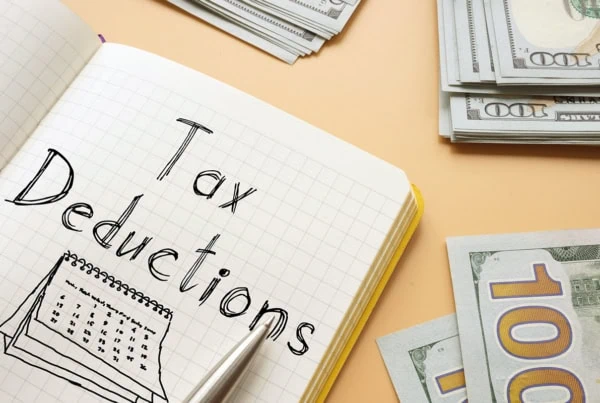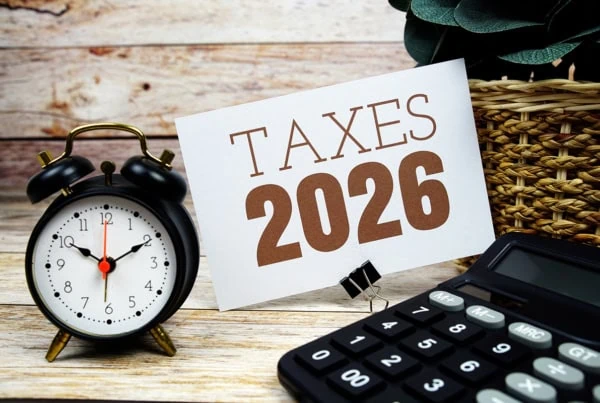Table of Contents
What is Depreciation?
Depreciation is an annual allowance given to a trade or business for exhaustion, wear and tear, and normal obsolescence of assets. An asset’s basis must be reduced by the depreciation allowed (or allowable) for a particular year, even if depreciation was not claimed by the taxpayer for that particular year. Traditionally, companies invest in an asset, determine its expected useful life, and allocate depreciation expense equivalent to the loss in value across time. Under the tax code, the IRS oversees a more rewarding accelerated depreciation system to induce companies to invest and expand their operations, thereby accelerating economic growth. Or so accelerated depreciation advocates would argue. Despite the unclear evidence of whether accelerated depreciation truly increases investment in the long-run, it has provided companies to use time value of money to their advantage. Corporations use MACRS depreciation, bonus depreciation, and Section 179 deductions to accelerate their depreciation expense from a tax perspective. Doing so lowers their tax burden today when a dollar has more value while increasing tax payments in the future when the dollar is worth less. In other words, the total taxes paid result in the same amount but when they go out the door differs.What is Basis from a Tax Perspective?
Basis is the amount paid for an asset plus other related costs to acquire the asset, such as sales tax, shipping, and installation, less depreciation taken. The basis will change over time and is used to figure the gain or loss upon asset disposal. For example, if a taxpayer purchases a piece of equipment to be used in a business and it costs $100,000 but has $5,000 in shipping and installation costs and $3,500 in sales tax. The property’s basis is $108,500 ($100,000 + $5,000 + $3,500). When a taxpayer depreciates the property and adjusts the basis downward, this asset has a lower adjusted basis or tax basis of the asset. As time passes, the adjusted basis will continue to decline unless an improvement is made to the asset. If an improvement occurs to an asset, the amount must be capitalized if it results in a betterment to the asset. The same occurs for when an asset adapts to a new or difference use or results in a restoration of the asset. These changes will affect the basis of all Section 1231, 1245, and 1250 property.What Are the Requirements for Depreciating Tangible and Intangible Property?
Depreciation also counts as an income tax deduction on most types of tangible property (except land) such as buildings, machinery, vehicles, furniture, and equipment. Likewise, certain intangible property, such as patents, patient and customer lists, copyrights, and off-the-shelf computer software qualify for depreciation and amortization expense. In order for a taxpayer to claim a depreciation deduction for property, it must meet the following requirements:- Taxpayer must own the property (qualified leasehold improvements made to leased property also qualify for depreciation treatment)
- Taxpayer must use the property in a trade or business which seeks to produce income (claiming depreciation expense has a “more than 50 percent business-use requirement and therefore the taxpayer may only deduct the portion associated with business use)
- Property must have a determinable useful life of one year or more
What is the Section 179 Deduction?
Think of the Section 179 deduction as a form of accelerated depreciation. Instead of the taxpayer waiting multiple years to deduct depreciation expense from taxable income, the taxpayer may depreciate the entire cost in the year of purchase, subject to limitations. Section 179 allows taxpayers employed in a trade or business to deduct the cost of certain property as an expense when placed in-service during the tax year. Traditionally, Section 179 expense capped at $500,000 and had a phase-out limit of $2,000,000. However, these limits increased under tax reform in 2018 to $1,000,000 and $2,500,000, respectively. Further, these amounts index for inflation each year. This deduction applies to new and used equipment as well as off-the-shelf software. To claim the deduction in tax year 2019, the equipment must be financed or purchased and placed in-service during 2019. This expense can be claimed by businesses and taken as a self-employment tax deduction. Form W-2 employees may not claim this deduction as any asset would be considered for personal use.What is Section 168 Depreciation (MACRS and Bonus)?
The depreciation deduction provided by Section 167(a) for tangible property placed in service after 1986 generally falls under IRC Section 168 (MACRS). These provisions exist for firms unable to claim the Section 179 allowance and may recover the cost of qualified assets over longer periods of time. Section 168 (MACRS) prescribes two methods of accounting for determining depreciation allowances:- General depreciation system (GDS) in Section 168(a)
- Alternative depreciation system (ADS) under Section 168(g)
What are the Section 179 Limit Deductions for 2018 and 2019?
Each tax year, a taxpayer may deduct as an expense in lieu of depreciation, a fixed amount of depreciable property (e.g., machinery, equipment, computer software, etc.). Under tax reform, the limit for 2018 and 2019 is $1,000,000 for new or used personal property acquired from an unrelated party. Specific to the Section 179 deduction, it reduces dollar-for-dollar on an asset placed in service during the taxable year which exceeds $2,500,000 in value. For example, when a taxpayer places a $2,600,000 asset in-service, the $100,000 excess over the investment limit reduces the available Section 179 deduction to $900,000 ($1,000,000 limit – $100,000). Following this math to its conclusion, the Section 179 deduction investment limit caps out on equipment at or above $3,500,000. Above this threshold, the taxpayer cannot claim a Section 179 deduction on the property. In this case, use of bonus depreciation and MACRS depreciation will apply. Also, taxpayers cannot take the 179 deduction when a net operating loss exists or if the deduction would create a loss. For historical context, the maximum expensing allowances and investment limitations from 1987 to 2018 are shown in the table below.Maximum Expensing Allowance and Investment Limitation (1987-2018 onward)
| Year | Maximum Expensing Allowance | Investment Limitation |
|---|---|---|
| 1987-1992 | $10,000 | $200,000 |
| 1993-1996 | $17,500 | $200,000 |
| 1997 | $18,000 | $200,000 |
| 1998 | $18,500 | $200,000 |
| 1999 | $19,000 | $200,000 |
| 2000 | $20,000 | $200,000 |
| 2001 and 2002 | $24,000 | $200,000 |
| 2003 | $100,000 | $400,000 |
| 2004 | $102,000 | $410,000 |
| 2005 | $105,000 | $420,000 |
| 2006 | $108,000 | $430,000 |
| 2007 | $125,000 | $500,000 |
| 2008 and 2009 | $250,000 | $800,000 |
| 2010-2017 | $500,000 | $2,000,000 |
| 2018 and thereafter | $1,000,000 | $2,500,000 |
| Source: Internal Revenue Service revenue procedures dating back to 1987. | ||
| The maximum allowance and investment limitation were both indexed for inflation from 2004-2006, and they are indexed for inflation from 2016 and thereafter. | ||
Multiple Forms of Depreciation Example
Generally, when a company invests in assets eligible for both the Section 179 and Section 168(k) (MACRS) expensing allowances, they must follow a prescribed order when claiming depreciation expense. Specifically, the Section 179 expensing occurs first, thereby lowering the basis in the asset by this amount. The taxpayer may then choose to apply bonus depreciation to any remaining basis, further reducing the basis in the property. Finally, the taxpayer may claim an allowance under the MACRS method using the double declining balance method.Equipment Purchases: $1,250,000
First Year Write Off ($1,000,000 – 2018 maximum): $1,000,000
100% Bonus First Year Depreciation (100% via TCJA): $250,000
Normal First Year MACRS (10% in first year of 10-year half-year convention): $0
Total First Year Deduction ($1,000,000 + $250,000): $1,250,000
Cash Savings ($1,250,000 * 21% Tax Rate): $262,500
Equipment Cost After-Tax (21% bracket): $987,500
Section 179 Deduction vs. MACRS Depreciation Deduction
Let’s look at an example comparing the Section 179 deduction vs. MACRS depreciation deduction and see how the depreciation allowances differ. Assume WealthUp Co (YATI Co) placed a $100,000 piece of five-year equipment into service. Under MACRS, the deprecation deduction comes to $20,000 ($100,000 * 20%, see MACRS depreciation table for MACRS factor). Under Section 179, YATI Co can expense the entire piece of equipment in year 1, amounting to $100,000 of depreciation expense. In this case, electing Section 179 yields the greatest deduction. However, from a tax planning perspective, if YATI Co is in a loss position (cannot take Section 179 in this instance) or sees the need for greater deductions in the future (offsetting higher expected future taxable income), depreciating the asset under normal MACRS convention would be best.How did Tax Reform Change Section 179 Property?
Prior to the changes seen under TCJA, section 179 property included most depreciable tangible personal property. TCJA reclassified many of the eligible categories for the Section 179 deduction, thereby making them more generalized and easier to claim against. For example, prior to TCJA, the only buildings or land improvements which qualified for section 179 expensing included restaurant buildings and certain building improvements to leased space. In other words, leasehold improvements to prepare a rented space for better functionality. Since TCJA, these restrictions have been removed and a broader category for qualified improvement property has come into effect. Section 179 expensing now includes certain structural components of a building like HVAC systems, fire protection and alarm systems, and security systems. Now, the tax code only restricts claiming a Section 179 deduction if these improvements relate to residential rental buildings.Pros and Cons of the Section 179 Deduction
The ability to lower taxable income significantly makes the Section 179 deduction attractive to many businesses looking to maximize their tax savings. Businesses facing the following situations may find the Section 179 particularly attractive:- Businesses Starting Up Operations. Because businesses face high start-up costs from purchasing machinery, computers, office equipment and furniture, as well as other long-lived assets, having the ability to deduct these expenses in year one can lower tax burdens early in their journey.
- Simplified Bookkeeping for Businesses. Because the business expenses these assets in year one, they will not need to capitalize an asset and depreciate it over multiple years. The Section 179 deduction allows the business to record the asset purchase as an expense.
- High Tax-Bracket Businesses. For owners or businesses in a high tax bracket, using the Section 179 deduction can dramatically reduce taxable income, thereby the amount of money subject to the highest tax brackets. This can result in major tax savings.
- Property placed in-service exceeds $2.5 million threshold. When you face this situation, Section 179 deduction investment limits trigger and reduce the amount of benefit.
- Filing jointly or separately. In this situation, an agreement needs to be struck on how each spouse will claim the Section 179 deduction otherwise it will split evenly between both.
What Qualifies as Section 179 Property?
All businesses which purchase, finance, and/or lease new or used business equipment during tax year 2019 should qualify for the Section 179 deduction. This assumes the qualifying property does not exceed $3,500,000 in value. In most circumstances, qualifying property includes machinery and equipment used in:- manufacturing, mining, transportation, communications, the generation and transmission of electricity, gas and water distribution, and sewage disposal.
- research and bulk storage facilities
- single-purpose agricultural structures
- storage facilities for petroleum products
- railroad grading and tunnel bores
- improvements to the interior of nonresidential real property
- fire protection and alarm systems
- security systems
- roofs
- heating, ventilation, and HVAC (heating, ventilation and air conditioning) systems installed in such property
Do Vehicles Qualify for Section 179?
Certain vehicles qualify for Section 179 deductions under the tax code. Specifically, sport utility vehicles (SUVs) with a gross vehicle weight rating above 6,000 lbs., but no more than 14,000 lbs., qualify for deducting up to $25,000 under the Section 179 deduction. You may claim this the year you purchased the vehicle. If the taxpayer uses the vehicle for both personal and business use, it must be used more than 50% of the time to qualify for the Section 179 deduction. If the taxpayer uses it for less than this amount, the taxpayer cannot claim the Section 179 deduction against the value of the vehicle. Not even in a pro-rated amount. In my accounting classes, my professor referred to the Section 179 deduction as the “SUV Tax Loophole”, or in her case, the “Hummer Deduction”. She said as much because many businesses opted to purchase qualifying vehicles (e.g., large SUVs and Hummers) and write them off. Congress has since modified the tax code with new limits, but the deduction can still count against vehicle purchases. Vehicles used in a trade or business qualify, but certain passenger vehicles have a total deduction limitation of $11,160, while other vehicles likely to be used almost solely for a business qualify for the full deduction. Many vehicles qualify for the deduction, but speaking in general terms, work vehicles primarily used for a trade or business require the following characteristics for Section 179 expensing:- Vehicles able to seat 9+ passengers behind the driver’s seat (e.g., Hotel or Airport shuttle vans, full-size summer camp vans, school buses, etc.)
- Vehicles containing (1) a fully-enclosed driver’s compartment or cargo area, (2) no seating behind the driver’s seat, and (3) no body section protruding more than 30 inches ahead of the leading edge of the windshield. This is all a fancy way of specifying a classic full-size cargo van. No seating in the rear and only meant for delivery or transportation (e.g., an HVAC or broadband service van, package delivery van, or other service provider)
- Heavy construction equipment (e.g., forklift)
- “Over-the-road” Tractor Trailers





![What’s Your Capital Gains Tax Rate? [2025 + 2026] 4 whats your capital gains tax rate](https://youngandtheinvested.com/wp-content/uploads/whats-your-capital-gains-tax-rate-600x403.webp)
